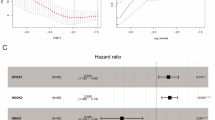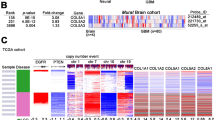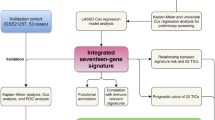Abstract
Osteosarcoma (OS), the most common malignant bone tumor, is characterized by heterogeneous tumor cells and abundant microenvironmental components. The extracellular matrix (ECM)—a complex and dynamic network surrounding tumor cells—plays a pivotal role in OS malignancy (e.g., cell proliferation, metastasis), making insights into ECM involvement critical for advancing OS prognosis. This study conducted bioinformatic analyses on bulk RNA-sequencing and single-cell RNA sequencing data from public databases, initially identifying collagen type V alpha 2 (COL5A2) as a key gene in OS progression. It further validated biological functions and underlying mechanisms of COL5A2 via in vitro experiments, and constructed and validated prognostic models based on ECM signature cell clusters. Results identified osteoblastic cells (OCs) and endothelial cells (ECs) as core cellular components of OS. COL5A2 was highly expressed in OCs, and high COL5A2 expression correlated with significantly reduced overall survival in OS patients. Western blot, CCK-8, and colony formation assays demonstrated that COL5A2 promoted OS cell proliferation by activating the focal adhesion pathway and inducing phosphorylation of the FAK/Paxillin/Akt signaling axis. The prognostic model highlighted the C0 OCs cluster as clinically significant. CellChat analysis uncovered significant activation of the IGFBP pathway in both C0 OCs and C1 ECs, and identified the IGFBP3-TMEM219 axis as the key ligand-receptor pair mediating their crosstalk. This study establishes COL5A2 and the C0 OCs cluster as pivotal ECM-related signatures in OS, confirming COL5A2 drives OS proliferation through focal adhesion signaling and IGFBP3-TMEM219-mediated crosstalk—both representing promising therapeutic targets. Further investigation into ECM components is warranted to refine OS treatment strategies and improve clinical outcomes.
This is a preview of subscription content, access via your institution
Access options
Subscribe to this journal
Receive 12 print issues and online access
$259.00 per year
only $21.58 per issue
Buy this article
- Purchase on SpringerLink
- Instant access to full article PDF
Prices may be subject to local taxes which are calculated during checkout








Similar content being viewed by others
Data availability
All the datasets analyzed in this study are publicly available as described in the Materials and methods in the manuscript.
References
Meltzer PS, Helman LJ. New horizons in the treatment of osteosarcoma. N Engl J Med. 2021;385:2066–76.
Ritter J, Bielack SS. Osteosarcoma. Ann Oncol. 2010;21:vii320–vii5.
Chen C, Xie L, Ren T, Huang Y, Xu J, Guo W. Immunotherapy for osteosarcoma: Fundamental mechanism, rationale, and recent breakthroughs. Cancer Lett. 2021;500:1–10.
Chen C-L, Zhang L, Jiao Y-R, Zhou Y, Ge Q-F, Li P-C, et al. miR-134 inhibits osteosarcoma cell invasion and metastasis through targeting MMP1 and MMP3 in vitro and in vivo. FEBS Lett. 2019;593:1089–101.
Wedekind MF, Wagner LM, Cripe TP. Immunotherapy for osteosarcoma: where do we go from here?. Pediatr Blood Cancer. 2018;65:e27227.
Wang G, Tang S, Chai L, Liang Y, Li T, Bi W, et al. The efficacy and safety of pegylated liposomal doxorubicin-based neoadjuvant chemotherapy in children with osteosarcoma: a retrospective real-world study. Cancer Innov. 2025;4:e162.
Xiong Y, Wu S, Du Q, Wang A, Wang Z. Integrated analysis of gene expression and genomic aberration data in osteosarcoma (OS). Cancer Gene Ther. 2015;22:524–9.
Corre I, Verrecchia F, Crenn V, Redini F, Trichet V. The osteosarcoma microenvironment: a complex but targetable ecosystem. Cells. 2020;9:976.
Liu Y, Han X, Han Y, Bi J, Wu Y, Xiang D, et al. Integrated transcriptomic analysis systematically reveals the heterogeneity and molecular characterization of cancer-associated fibroblasts in osteosarcoma. Gene. 2024;907:148286.
Cersosimo F, Lonardi S, Bernardini G, Telfer B, Mandelli GE, Santucci A, et al. Tumor-associated macrophages in osteosarcoma: from mechanisms to therapy. Int J Mol Sci. 2020;21:5207.
Cui J, Dean D, Hornicek FJ, Chen Z, Duan Z. The role of extracelluar matrix in osteosarcoma progression and metastasis. J Exp Clin Cancer Res. 2020;39:178.
Yang Q, Liu J, Wu B, Wang X, Jiang Y, Zhu D. Role of extracellular vesicles in osteosarcoma. Int J Med Sci. 2022;19:1216–26.
Wishart AL, Conner SJ, Guarin JR, Fatherree JP, Peng Y, McGinn RA, et al. Decellularized extracellular matrix scaffolds identify full-length collagen VI as a driver of breast cancer cell invasion in obesity and metastasis. Sci Adv. 2020;6:eabc3175.
Cox TR. The matrix in cancer. Nat Rev Cancer. 2021;21:217–38.
Huang J, Zhang L, Wan D, Zhou L, Zheng S, Lin S, et al. Extracellular matrix and its therapeutic potential for cancer treatment. Sig Transduct Target Ther. 2021;6:153.
Wei L, Ye H, Li G, Lu Y, Zhou Q, Zheng S, et al. Cancer-associated fibroblasts promote progression and gemcitabine resistance via the SDF-1/SATB-1 pathway in pancreatic cancer. Cell Death Dis. 2018;9:1065.
Wei L, Ye H, Li G, Lu Y, Zhou Q, Zheng S, et al. Correction: Cancer-associated fibroblasts promote progression and gemcitabine resistance via the SDF-1/SATB-1 pathway in pancreatic cancer. Cell Death Dis. 2021;12:232.
Winkler J, Abisoye-Ogunniyan A, Metcalf KJ, Werb Z. Concepts of extracellular matrix remodelling in tumour progression and metastasis. Nat Commun. 2020;11:5120.
Chakravarthy A, Khan L, Bensler NP, Bose P, De Carvalho DD. TGF-β-associated extracellular matrix genes link cancer-associated fibroblasts to immune evasion and immunotherapy failure. Nat Commun. 2018;9:4692.
Rahbari NN, Kedrin D, Incio J, Liu H, Ho WW, Nia HT, et al. Anti-VEGF therapy induces ECM remodeling and mechanical barriers to therapy in colorectal cancer liver metastases. Sci Transl Med. 2016;8:360ra135.
Chen J, Liu Y, Lan J, Liu H, Tang Q, Li Z, et al. Identification and validation of COL6A1 as a novel target for tumor electric field therapy in glioblastoma. CNS Neurosci Ther. 2024;30:e14802.
Chen D, Le SB, Hutchinson TE, Calinescu A-A, Sebastian M, Jin D, et al. Tumor Treating Fields dually activate STING and AIM2 inflammasomes to induce adjuvant immunity in glioblastoma. J Clin Invest. 2022;132:e149258.
Satija R, Farrell JA, Gennert D, Schier AF, Regev A. Spatial reconstruction of single-cell gene expression data. Nat Biotechnol. 2015;33:495–502.
Cheng D, Zhang Z, Liu D, Mi Z, Tao W, Fu J, et al. Unraveling T cell exhaustion in the immune microenvironment of osteosarcoma via single-cell RNA transcriptome. Cancer Immunol Immunother CII. 2024;73:35.
Liu Y, Feng W, Dai Y, Bao M, Yuan Z, He M, et al. Single-cell transcriptomics reveals the complexity of the tumor microenvironment of treatment-naive osteosarcoma. Front Oncol. 2022;12:1077067.
Chen G, Shan H, Xiong S, Zhao Y, van Gestel CAM, Qiu H, et al. Polystyrene nanoparticle exposure accelerates ovarian cancer development in mice by altering the tumor microenvironment. Science total Environ. 2024;906:167592.
Liu Y, Feng W, Dai Y, Bao M, Yuan Z, He M, et al. Single-cell transcriptomics reveals the complexity of the tumor microenvironment of treatment-naive osteosarcoma. Front Oncol. 2021;11:709210.
Mensali N, Köksal H, Joaquina S, Wernhoff P, Casey NP, Romecin P, et al. ALPL-1 is a target for chimeric antigen receptor therapy in osteosarcoma. Nat Commun. 2023;14:3375.
Wu Z, Wang Z, Hua Z, Ji Y, Ye Q, Zhang H, et al. Prognostic signature and immunotherapeutic relevance of Focal adhesion signaling pathway-related genes in osteosarcoma. Heliyon. 2024;10:e38523.
Yu Q, Xiao W, Sun S, Sohrabi A, Liang J, Seidlits SK. Extracellular matrix proteins confer cell adhesion-mediated drug resistance through integrin α V in glioblastoma cells. Front Cell Dev Biol. 2021;9:616580.
Zhao J, Guan J-L. Signal transduction by focal adhesion kinase in cancer. Cancer Metastasis Rev. 2009;28:35–49.
Luchetti F, Crinelli R, Cesarini E, Canonico B, Guidi L, Zerbinati C, et al. Endothelial cells, endoplasmic reticulum stress and oxysterols. Redox Biol. 2017;13:581–7.
Spinelli JB, Yoon H, Ringel AE, Jeanfavre S, Clish CB, Haigis MC. Metabolic recycling of ammonia via glutamate dehydrogenase supports breast cancer biomass. Science. 2017;358:941–6.
Heng L, Jia Z, Bai J, Zhang K, Zhu Y, Ma J, et al. Molecular characterization of metastatic osteosarcoma: Differentially expressed genes, transcription factors and microRNAs. Mol Med Rep. 2017;15:2829–36.
Chao C-C, Lee W-F, Yang W-H, Lin C-Y, Han C-K, Huang Y-L, et al. IGFBP-3 stimulates human osteosarcoma cell migration by upregulating VCAM-1 expression. Life Sci. 2021;265:118758.
Prakash J, Shaked Y. The interplay between extracellular matrix remodeling and cancer therapeutics. Cancer Discov. 2024;14:1375–88.
Giussani M, Triulzi T, Sozzi G, Tagliabue E. Tumor extracellular matrix remodeling: new perspectives as a circulating tool in the diagnosis and prognosis of solid tumors. Cells. 2019;8:81.
Eble JA, Niland S. The extracellular matrix in tumor progression and metastasis. Clin Exp Metastasis. 2019;36:171–98.
Han YL, Luo D, Habaxi K, Tayierjiang J, Zhao W, Wang W, et al. COL5A2 inhibits the TGF-β and Wnt/β-catenin signaling pathways to inhibit the invasion and metastasis of osteosarcoma. Front Oncol. 2022;12:813809.
Chen M, Zhu X, Zhang L, Zhao D. COL5A2 is a prognostic-related biomarker and correlated with immune infiltrates in gastric cancer based on transcriptomics and single-cell RNA sequencing. BMC Med Genomics. 2023;16:220.
Salimian N, Peymani M, Ghaedi K, Hashemi M, Rahimi E. Collagen 1A1 (COL1A1) and Collagen11A1(COL11A1) as diagnostic biomarkers in Breast, colorectal and gastric cancers. Gene. 2024;892:147867.
Paul AM, George B, Saini S, Pillai MR, Toi M, Costa L, et al. Delineation of pathogenomic insights of breast cancer in young women. Cells. 2022;11:1927.
Jin Y, Song X, Sun X, Ding Y. Up-regulation of collagen type V alpha 2 (COL5A2) promotes malignant phenotypes in gastric cancer cell via inducing epithelial-mesenchymal transition (EMT). Open Med. 2023;18:20220593.
Gong H, Tao Y, Xiao S, Li X, Fang K, Wen J, et al. Identification of an EMT-related gene-based prognostic signature in osteosarcoma. Cancer Med. 2023;12:12912–28.
Chauhan A, Khan T. Focal adhesion kinase-An emerging viable target in cancer and development of focal adhesion kinase inhibitors. Chem Biol Drug Des. 2021;97:774–94.
Zhang Y, Liu Z, Yang X, Lu W, Chen Y, Lin Y, et al. H3K27 acetylation activated-COL6A1 promotes osteosarcoma lung metastasis by repressing STAT1 and activating pulmonary cancer-associated fibroblasts. Theranostics. 2021;11:1473–92.
Maller O, Drain AP, Barrett AS, Borgquist S, Ruffell B, Zakharevich I, et al. Tumour-associated macrophages drive stromal cell-dependent collagen crosslinking and stiffening to promote breast cancer aggression. Nat Mater. 2021;20:548–59.
Wang L, Li C, Wang J, Yang G, Lv Y, Fu B, et al. Transformable ECM deprivation system effectively suppresses renal cell carcinoma by reversing anoikis resistance and increasing chemotherapy sensitivity. Adv Mater. 2022;34:e2203518.
D’Addio F, Montefusco L, Lunati ME, Pastore I, Assi E, Petrazzuolo A, et al. Targeting a novel apoptotic pathway in human disease. Bioessays. 2023;45:e2200231.
D’Addio F, Maestroni A, Assi E, Ben Nasr M, Amabile G, Usuelli V, et al. The IGFBP3/TMEM219 pathway regulates beta cell homeostasis. Nat Commun. 2022;13:684.
Acknowledgements
This work was financially supported by National Natural Science Foundation of China (grant number: 82403886, 82002842), and the National Defense Science and Technology Fund for Distinguished Young Scholars (grant number: 2022-JCJQ-ZQ-018), and Innovation Science Fund of the Fourth Medical Center of PLA General Hospital (grant number: 2025-4ZX-MS-03).
Author information
Authors and Affiliations
Contributions
Yuyang Liu and Yuchen Han: Data analysis, experiments, writing review and editing. Zixuan Guo: Investigation and methodology. Yinglong Zhang and Xiuyuan Xu: Investigation and writing review. Jianxiong Li, Meng Xu and Wenting Qi: Designed the study, funding acquisition, project administration, supervision, data analysis and interpretation, and writing-original draft. All authors contributed to the systematic review of the published findings and sources. They all read and approved the final manuscript.
Corresponding authors
Ethics declarations
Competing interests
The authors declare no competing interests.
Ethics
All methods were performed in accordance with the relevant guidelines and regulations. The protocol for this study was approved by the Ethics Committee of the Fourth Medical Center of Chinese PLA General Hospital (agreement number: 2024KY0112-KS001).
Additional information
Publisher’s note Springer Nature remains neutral with regard to jurisdictional claims in published maps and institutional affiliations.
Supplementary information
Rights and permissions
Springer Nature or its licensor (e.g. a society or other partner) holds exclusive rights to this article under a publishing agreement with the author(s) or other rightsholder(s); author self-archiving of the accepted manuscript version of this article is solely governed by the terms of such publishing agreement and applicable law.
About this article
Cite this article
Liu, Y., Han, Y., Guo, Z. et al. Unveiling the role of the extracellular matrix in the osteosarcoma tumor microenvironment through integrated transcriptomics and experimental validation. Cancer Gene Ther (2025). https://doi.org/10.1038/s41417-025-00970-0
Received:
Revised:
Accepted:
Published:
DOI: https://doi.org/10.1038/s41417-025-00970-0



